Debunking Common Myths about Steel Bars

What are the common myths about steel bars?
- Steel bars are heavy and difficult to handle
- Steel bars are prone to rust and corrosion
- All steel bars are created equal
- Steel bars are expensive to maintain
- Steel bars are not environmentally friendly
Overview
- Steel bars are crucial components in construction, providing strength and durability to structures.
- This article debunks common myths about steel bars, such as them being heavy and difficult to handle, prone to rust, and expensive to maintain.
Steel bars, also known as reinforcing bars or rebars, are critical to concrete and masonry structures, offering essential tensile strength and support. These versatile components are integral to foundations, columns, walls, and other structural elements, ensuring the durability and longevity of buildings.
Despite their importance, common myths about steel bars are going around, which can lead to suboptimal construction decisions. As a leading steel supplier in the Philippines, Metal Exponents Inc. is dedicated to debunking these misconceptions to promote accurate knowledge and best practices in the construction industry.
Steel Bars are Heavy and Difficult to Handle
While steel can be heavier than some alternative materials, modern engineering has produced various types of steel bars designed to be more manageable. Advances in production techniques have led to steels that are stronger and lighter than traditional options.
Although these bars do have significant weight, their handling can be optimized with the appropriate tools and techniques, making them easier to transport and install than many might assume.
In construction, specialized machinery such as cranes and hoists are routinely employed to lift and position steel bars, addressing the challenges posed by their weight.
The notion that they are difficult to handle often arises from a lack of understanding of their applications and the equipment available for their manipulation.
Steel Bars are Prone to Rust and Corrosion

They are engineered with specific compositions and undergo rigorous quality control to minimize rust and corrosion risks. Their manufacturing process includes adding alloying elements such as chromium and nickel, which form a protective oxide layer on the bar’s surface. This layer is the barrier, preventing moisture, oxygen, and other corrosive agents from penetrating and causing rust.
While they are not entirely rust-proof, adhering to industry-standard practices—such as keeping the bars elevated from the ground and covering them to shield them from the elements—can reduce the risk of rust and corrosion.
All Steel Bars are Created Equal
Differences in manufacturing processes and materials can lead to variations in mechanical properties such as strength, ductility, and corrosion resistance. This myth may mislead you into thinking any steel bar will suffice, potentially compromising the structural integrity and longevity of your projects.
A key factor in these variations is the specific alloying elements and their proportions. While all steel contains iron and carbon, the addition of elements like manganese, silicon, or chromium can enhance certain properties.
These differences affect how steel bars perform under stress, bond with concrete, and endure in various environmental conditions. Thus, selecting the right type of steel is essential to ensuring a construction project’s safety and long-term performance.
Steel Bars are Expensive to Maintain

Although steel bars may represent an upfront investment, they prove to be highly cost-effective in the long term. Steel’s durability and resistance to wear and tear minimize the need for frequent repairs and replacements, leading to long-term savings.
With proper maintenance, they can last for decades without major repairs. Unlike wood, which can rot or warp, or concrete, which can crack or deteriorate, these bars remain unaffected by these issues.
Steel Bars are Not Environmentally Friendly
One of the common myths about steel bars is they are harmful to the environment. In reality, they are an eco-friendly choice for construction.
Steel is highly recyclable and can be melted down and reused indefinitely without losing its properties. At the end of a building’s life cycle, it can be easily recovered and repurposed into new products, reducing waste and conserving natural resources.
As a matter of fact, the steel industry leads in recycling efforts, with a global recycling rate exceeding 40%. Thanks to its high recyclability and the industry’s commitment to sustainability, steel remains one of the most environmentally friendly materials available for construction.
Key Takeaway
Understanding the truth behind common myths about steel bars is essential for anyone involved in the construction industry. Many of these misconceptions can lead to poor material choices, which ultimately affect the safety and durability of structures. By clarifying these, we encourage a more nuanced understanding of materials, ultimately leading to better construction practices.
Do you need a high-quality steel bar for your project? At Metal Exponents Inc., we got you covered! We offer a wide selection of high-quality structural steel at unbeatable prices. Contact us now to learn more and take your project to the next level.


